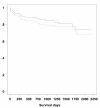Model of end stage liver disease (MELD) score greater than 23 predicts length of stay in the ICU but not mortality in liver transplant recipients
- PMID: 20550662
- PMCID: PMC2911764
- DOI: 10.1186/cc9068
Model of end stage liver disease (MELD) score greater than 23 predicts length of stay in the ICU but not mortality in liver transplant recipients
Abstract
Introduction: The impact of model of end stage liver disease (MELD) score on postoperative morbidity and mortality is still elusive, especially for high MELD. There are reports of poorer patient outcome in transplant candidates with high MELD score, others though report no influence of MELD score on outcome and survival.
Methods: We retrospectively analyzed data of 144 consecutive liver transplant recipients over a 72-month period in our transplant unit, from January 2003 until December 2008 and performed uni- and multivariate analysis for morbidity and mortality, in particular to define the influence of MELD to these parameters.
Results: This study identified MELD score greater than 23 as an independent risk factor of morbidity represented by intensive care unit (ICU) stay longer than 10 days (odds ratio 7.0) but in contrast had no negative impact on mortality. Furthermore, we identified transfusion of more than 7 units of red blood cells as independent risk factor for mortality (hazard ratio 7.6) and for prolonged ICU stay (odds ratio [OR] 7.8) together with transfusion of more than 10 units of fresh frozen plasma (OR 11.6). Postoperative renal failure is a strong predictor of morbidity (OR 7.9) and postoperative renal replacement therapy was highly associated with increased mortality (hazard ratio 6.8), as was hepato renal syndrome prior to transplantation (hazard ratio 13.2).
Conclusions: This study identified MELD score greater than 23 as an independent risk factor of morbidity represented by ICU stay longer than 10 days but in contrast had no negative impact on mortality. This finding supports the transplantation of patients with high MELD score but only with knowledge of increased morbidity.
Figures



Similar articles
-
The combination of MELD score and ICG liver testing predicts length of stay in the ICU and hospital mortality in liver transplant recipients.BMC Anesthesiol. 2014 Nov 15;14:103. doi: 10.1186/1471-2253-14-103. eCollection 2014. BMC Anesthesiol. 2014. PMID: 25844060 Free PMC article.
-
Liver Transplantation in Recipients With High Model for End-stage Liver Disease Score.Transplant Proc. 2018 Mar;50(2):595-597. doi: 10.1016/j.transproceed.2017.12.032. Transplant Proc. 2018. PMID: 29579862
-
Liver Transplantation Outcomes in Recipients with High Model for End-Stage Liver Disease (MELD) Scores: The Relevance of MELD Scores.Ann Transplant. 2017 Apr 25;22:251-256. doi: 10.12659/aot.901045. Ann Transplant. 2017. PMID: 28439063
-
Postoperative resource utilization and survival among liver transplant recipients with Model for End-stage Liver Disease score ≥ 40: A retrospective cohort study.Can J Gastroenterol Hepatol. 2015 May;29(4):185-91. doi: 10.1155/2015/954656. Can J Gastroenterol Hepatol. 2015. PMID: 25965438 Free PMC article.
-
Nursing Team Workload and the Apache Index of Gravity of Patients Post Liver Transplantation: A Cohort Study.Transplant Proc. 2022 Oct;54(8):2295-2300. doi: 10.1016/j.transproceed.2022.08.039. Epub 2022 Oct 11. Transplant Proc. 2022. PMID: 36229278 Review.
Cited by
-
Elevation of HO-1 Expression Mitigates Intestinal Ischemia-Reperfusion Injury and Restores Tight Junction Function in a Rat Liver Transplantation Model.Oxid Med Cell Longev. 2015;2015:986075. doi: 10.1155/2015/986075. Epub 2015 May 10. Oxid Med Cell Longev. 2015. PMID: 26064429 Free PMC article.
-
Developing a Novel Artificial Intelligence Framework to Measure the Balance of Clinical Versus Nonclinical Influences on Posthepatectomy Length of Stay.Ann Surg Oncol. 2025 May;32(5):3526-3538. doi: 10.1245/s10434-025-16942-5. Epub 2025 Feb 5. Ann Surg Oncol. 2025. PMID: 39907879 Free PMC article.
-
Hepatobiliary quiz-6 (2013).J Clin Exp Hepatol. 2013 Jun;3(2):171-6. doi: 10.1016/j.jceh.2013.05.006. J Clin Exp Hepatol. 2013. PMID: 25755495 Free PMC article. No abstract available.
-
Pretransplant Factors and Associations with Postoperative Respiratory Failure, ICU Length of Stay, and Short-Term Survival after Liver Transplantation in a High MELD Population.J Transplant. 2016;2016:6787854. doi: 10.1155/2016/6787854. Epub 2016 Nov 17. J Transplant. 2016. PMID: 27980860 Free PMC article.
-
Outcomes of hemi- versus whole liver transplantation in patients from mainland china with high model for end-stage liver disease scores: a matched analysis.BMC Surg. 2020 Nov 20;20(1):290. doi: 10.1186/s12893-020-00965-8. BMC Surg. 2020. PMID: 33218334 Free PMC article.
References
-
- Ravaioli M, Grazi GL, Ballardini G, Cavrini G, Ercolani G, Cescon M, Zanello M, Cucchetti A, Tuci F, Del Gaudio M, Varotti G, Vetrone G, Trevisani F, Bolondi L, Pinna AD. Liver transplantation with the Meld system: a prospective study from a single European center. Am J Transplant. 2006;6:1572–1577. doi: 10.1111/j.1600-6143.2006.01354.x. - DOI - PubMed
MeSH terms
LinkOut - more resources
Full Text Sources
Medical

